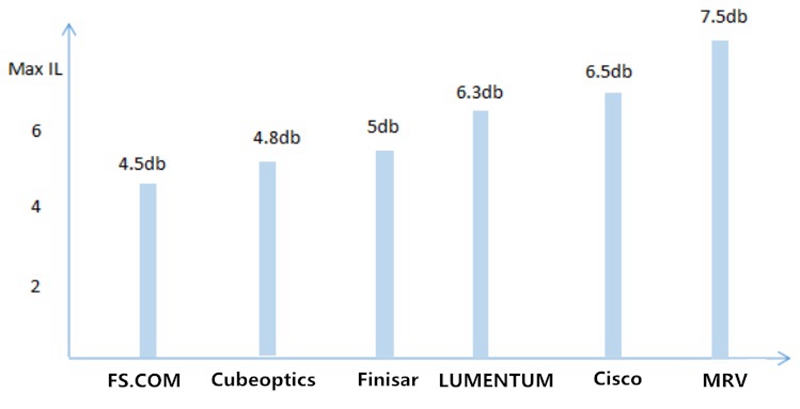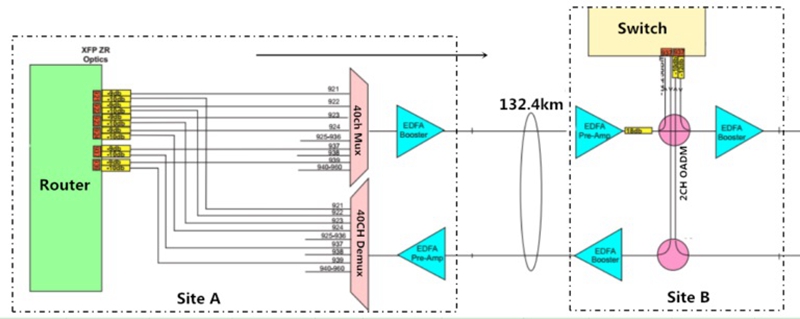Confused About Loss in the Long Haul DWDM Network?
četvrtak , 20.04.2017.As the optical network develops fast, today’s network needs much higher capacity than ever before, for carrying the large amount of data. Under this trend, the DWDM technology is come up with that can greatly expand the network capacity in long haul transmission. For those capacity-hungry applications, building a DWDM network is undoubtedly an economical solution that can transmit much more signals through only one singlemode fiber for a long distance. However, the DWDM network is very complicated which consists of various components like DWDM Mux Demux, EDFA optical amplifier and dispersion compensating module. Taking all these components into consideration, the detailed loss in the long haul DWDM network would be a puzzle for many users. To clear up the confusion, this paper will analysis what mainly cause the loss in the long haul DWDM network and learn how to calculate the loss budget in details.
What Mainly Cause the Loss in Long Haul DWDM Network?
It is well known that any components inserted into the a network will cause loss, more or less. For instance, if a DWDM Mux Demux for multiplexing signals is deployed in the network, the insertion loss will occur. Hence, when designing a DWDM network, you are highly suggested to make the whole loss budget clear, for ensuring the performance of your network.
DWDM Mux Demux: a key component in the DWDM network. It is designed for multiplexing several kinds of signals with different wavelengths and then carrying the integrated signal through one fiber. Considering that Mux Demux is a passive component without the function of amplifying the signals, its big insertion loss will affect the whole network loss. In order to reduce the cost for deploying the DWDM network, it is very necessary to choose a DWDM Mux Demux with less insertion loss.
In recent year, most DWDM Mux Demux manufacturers dedicate the reduction of insertion loss. Since the insertion loss are still very different among these manufacturers, here offers a figure that shows their maximum insertion loss of the 40 Channel DWDM Mux Demux. From the figure, we can learn six common DWDM Mux Demux manufacturers who provide the 40 Channel DWDM Mux Demux. Among these manufacturers, FS.COM, Cubeoptics and Finisar offers the Mux Demux with relatively low insertion loss that are high recommended, while others don’t.
Optical Add Drop Mux: another component deployed in the DWDM network. From its name, it is easy to learn that it enables individual or multiple wavelength channels to be added or dropped from an incoming link. When it is working, the signal will pass from the common port to add/drop port or from the add/drop port to the common port. The insertion loss will be caused during the process.
Dispersion Compensation Module: plays an important role in DWDM network. When the optical signals are deformed by the chromatic dispersion in the transmission, we can use this component to reshape the deformed signals. As it is very useful for receiving the right signals and avoiding transmitting errors, it is required to be inserted in the receiver end of the DWDM network which also cause the insertion loss.
Other Components: apart from the mentioned components, the singlemode fibers can also cause loss in DWDM network. Moreover, the longer the transmission distance is, the higher the loss will be. In addition, the EDFA optical amplifier should be also noted. When the loss in the DWDM network is too high and can’t support the long transmission, the EDFA optical amplifier will be used for boosting or adding gain of optical signals. Hence, the signal power can be balanced and the long transmission can be done.
How to Calculate the Loss Budget for the DWDM Network?
To understand how to calculate the whole loss budget, here offers a part of the long haul DWDM network deployment solution, designed by a user from UK. From the figure, we can learn the whole transmission distance is 132.4 km, from site A to Site B. The 40 channel DWDM Mux Demux, booster EDFA optical amplifier, pre-amplifier, 2 channel optical add drop mux and optical attenuators are installed for deploying the DWDM network. All these components will cause the loss or change and affect the whole network performance.
Now let’s calculate the budget loss from site A to site B:
A. The first loss of the link is caused by the use of an optical attenuator, between the router and the 40 channel DWDM Mux. It is -8.5dB.
B. When the signals pass through the DWDM Mux, the second loss, -4.5dB occurs. Then the output power is:-8.5dB-4.5dB =-13dB.
C. Then the signal will be boosted by the EDFA optical amplifier, and there is +23dB gain. At this time, the signal output power is: -13dB+23dB= +10dB.
D. Considering that the total loss of the fiber optic cable is: -0.22dB/km x132.4km = -29.13dB, the input power of the pre-amp EDFA is: +10dB-29.13dB = -19.13dB.
E. As the pre-amp EDFA gain is +26dB, so the output power is +6.87dB.
F. There is an attenuator with -18dB loss installed after the pre-amp EDFA. Hence, the output power after the attenuator is: +6.87dB-18dB = -11.13dB.
G. To enhance the signal, another EDFA optical amplifier installed in the receiver end. So that, the output power of site B is: +23dB-11.13dB=+10.67dB.
Conclusion
Since there are various components like EDFA optical amplifier, dispersion compensation module, optical add drop Mux and patch cables needed for building a long haul DWDM network, the loss may occur many times during the transmission. Hence, calculating the loss budget before building the DWDM network is very necessary. Only by making the whole loss budget clear, the power loss in the transmission can be controlled and the whole DWDM network performance can be ensured.
Oznake: Mux Demux, dispersion compensating module
komentiraj (0) * ispiši * #


